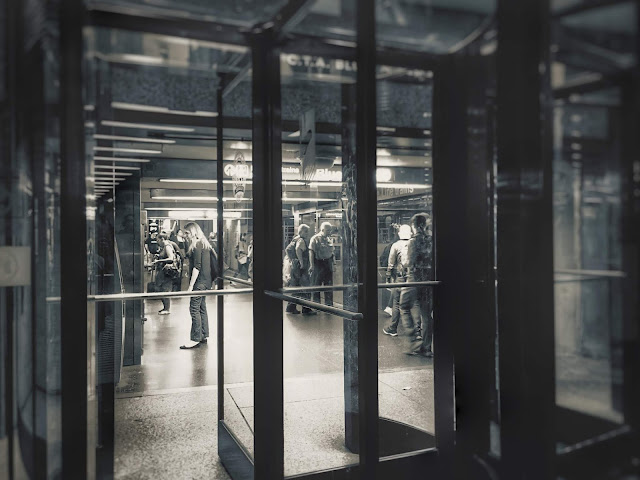Summer 2016
When the weather warms tourists flock to Chicago. Since I
get requests for advice about what to see and do in the city, I’ve compiled a budget
guide for visiting. Please feel free to leave your own tips.
Choosing What to Visit
Finding the expensive attractions is easy. They are well
known. They appear on every website and guide book. Whenever I travel I’m on a
limited budget and appreciate finding the cheap stuff. I prefer to blow my
money on one big great thing, then supplement the rest of the trip with low
cost or free activities.
The first time I go to a new city I spend most of the time
simply walking around. If I’ve already been somewhere I prefer a return visit
to explore a theme. In a metropolitan area as large as Chicago there is no way
to cover all the museums from Millennium Park north to Lincoln Park, let alone
the rest of the city. The sheer number of choices is overwhelming.
When friends come to visit I’m left trying to find out clues
about what might interest them. If they like architecture, do they want to
explore a larger area by walking on our own, or do they want a shorter, but
much more informative, professionally guided tour? Do they prefer trolley,
subway, bike or walking? (I draw the line at Segways.)
What aspect of architecture is compelling? Do they want
skylines and a history if how Chicago developed? Or do they have a specific
interest in churches, gothic architecture, hotel lobbies, Frank Lloyd Wright, park
district field houses and conservatories, high end retail buildings, famous
restaurants, train depots, public markets, or something else?
Pick a Theme
I like to explore a city around a theme. Right now I’m
interested in the Edwardian Era of history. In Chicago I would take some architectural
tours of buildings and foods (Chicagoans often combine architecture and eating
or drinking), check for museum exhibits, and visit some house museums like
Glessner.
If you’re looking for something educational you might
explore birds, Civil War history, cooking and foods, bridges, or whatever
floats your boat. Chicago has a number of museums and cultural centers devoted
to specific ethnic heritages, including Swedish, German, Lithuanian, African-American,
Ukrainian, Mexican and Puerto Rico.
Chicago has an endless number of tours, concerts and
lectures. The universities often have free or low cost theater, music and
lectures. Likewise, neighborhoods sponsor inexpensive events.
In my own neighborhood of Hyde Park this summer we’ll have a
series of free weekly evening concerts on our main street (53rd),
free park concerts and movies, a free 3-day Jazz Festival, gallery openings,
inexpensive museums on the University of Chicago campus, 4th of July
parade and picnics with fireworks all night, fire pits for cookouts at
Promontory Point, lectures, author readings, a new comedy club, and stuff I’m
probably forgetting.
We’re near the
Museum
of Science and Industry,
DuSable
Museum,
Stony Island
Arts Bank,
Hyde Park Art Center,
University of Chicago,
Court Theater,
Oriental Institute Museum,
Smart Museum of Art,
Renaissance Society,
Rockefeller Chapel,
Logan
Center for the Arts,
Robie
House,
Doc Films,
The Revival Improv Comedy Club,
The Promontory music club,
Black Cinema
House,
Arts + Public
Life, site of
White
City, Chicago World’s Fair,
Experimental
Station, and the
Japanese
Garden.
I haven’t listed the neighborhood restaurants, architecture,
main business district, book stores, public sculptures, the cluster of
seminaries, the lakefront, beaches, or the parks. We’re just one small area of
the city, yet we have more cultural institutions than some entire small cities.
Pick an Area of Town
I recommend sticking to a particular area of the city rather
than trying to cover a large territory. Why waste vacation time stuck sitting
in traffic or waiting for the subway? Some of the neighborhoods have easy
access on public transit to The Loop, Navy Pier, or the Magnificent Mile, but
plenty of neighborhoods don’t. If everything you want to do is near the Navy
Pier, paying higher hotel costs is worth the easy access.
Leave the Car at Home
I don’t recommend driving around Chicago. It may seem
cheaper, until you have to pay parking. Some hotels offer lower room rates with
expensive parking garages. Be sure to find out both. Driving to places like
downtown is a nightmare and you’ll have to pay for parking. Other neighborhoods
require a long search for a free spot.
You may find an inexpensive AirBnB rental with free parking.
Fine, but how are you going to get to tourist attractions? Will you have an
hour bus ride each way, including having to transfer? Are you going to drive and
pay high parking fees when you arrive at your destination?
You Don’t Have to Visit the Art Museum
I hereby give you permission to skip anything which doesn’t
interest you. You might be happier spending $300 on one of the best dinners of
your life rather than slogging through days of boring museums.
Budget Ideas
Since money doesn’t grow on trees, here are some ways to see
and do popular attractions without breaking the bank.
·
Discount Tickets: There are passes, Groupon, and
last minute discounts.
·
Skyline: Instead of the Willis or Hancock
towers, grab a drink at a rooftop bar.
·
River: Take the water taxi from Michigan Ave to
Chinatown.
·
Meet Up: Check for free public tours.
·
Museums: Visit less well known museums.
·
Discount Shopping: Chinatown, Clark St in
Andersonville, 26th St in Little Village
Links to Low Cost/Free Stuff
















































